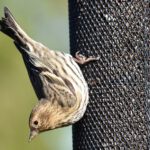Weaverbirds are songbirds found throughout sub-Saharan Africa, parts of Asia, and several surrounding islands. Numbering over 100 species, weaverbirds are named for their exceptionally elaborate and carefully woven nests – intricate structures made from plant fibers and other materials. While many birds weave nests out of twigs and grass, weaverbirds take nest building to a whole new level of complexity and artistry. In this article we talk about Exploring the Unique Nesting Habits of Weaverbirds.
Of all their traits, the weaverbirds’ nest-making abilities are among the most fascinating. Their nests come in a spectacular array of shapes, sizes, and materials. From massive community nests housing over 100 pairs to tiny, delicate purses hanging precariously over water, weaver nest architecture showcases an astonishing diversity and attention to detail.
Weaver Nesting Materials

Weaverbirds use a wide variety of plant-based materials to build their nests. The most common include grasses, leaves, twigs, rootlets, bamboo, vines, fibers from palm fronds, and strips of bark. Some species also incorporate man-made materials like string, plastic, paper, cloth scraps, or cigarette filters into their nests.
The materials used often depend on what’s locally available. The materials are carefully selected – weavers may travel surprisingly long distances to find just the right fibers or strips for their planned structures. Some species have clear preferences – the Cape weaver favors palm leaves while the masked weaver opts for grass stems. Village weavers are opportunistic foragers, mixing and matching all kinds of vegetation.
Nest Architecture Styles
While every weaver species builds uniquely styled nests, certain broad architectural styles can be defined. These include:
Globular: Large, round, hollow nests built from long grasses. Found across much of Africa.
Retort: Elongated nests with a tubular entrance tunnel made from strips of leaves or other fibers. Common in southern and eastern Africa.
Pendant: Small, round woven nests with a downward-facing entrance hole. Hung from slender branches over lakes and rivers. Found in sub-Saharan Africa and parts of Asia.
Social: Massive structures housing up to 300 birds in separate nesting chambers. Built cooperatively over years from sturdy branches and sticks. Found in parts of western and central Africa.
The diversity of shapes, sizes, materials and construction techniques is remarkable across the Ploceidae family of weavers. Even among the same species, nests can vary greatly between populations and locales. Their adaptability and skill allows weavers to flourish across widely differing habitats.
Unique Nest Features
Many weaver species incorporate special features into their nests that aid in stability, durability, temperature regulation, predation avoidance, or concealment. A few examples include:
Entrance Tunnels: Common in many pendant and retort nests. The tunnels provide shelter from weather and help hide the nest contents from predators. Some species build remarkably long tubes up to 2 feet in length.
Decorations: Village weavers are known to decorate the entrances of their nests with colorful objects like flower petals, bits of plastic or paper, and unusual seeds or fruit pulp. Some scientists think this helps attract mates.
Thatching Layers: Sociable weavers build their giant communal nests around a large central support structure from sticks, then add insulating layers of grasses. As the nest grows over generations, outer thatch layers can reach several feet thick.
False Nests: Male weavers of several species build crude “dummy nests” to establish nesting sites and attract potential mates. Sometimes up to a dozen fake nests are built per male until a female shows interest.
Roofed Nests: Some weaver species construct a waterproof roof layer over their nests for better insulation and weather protection. Roof layers are built from tightly woven palm fibers or leaves.
Why Such Complex Nests?
Weaverbirds pour astonishing amounts of time and effort into building their elaborate homes – why such dedication? Scientists think their nest-building behavior evolved for a few key reasons:
Protection: Their intricate nests form secure shelters from predators and harsh weather. Features like tunnels, thatching, and roofs offer excellent insulation and concealment.
Mate Attraction: More complex and beautiful nests signal male quality, catching the eyes of females. The most skillful nest builders land the best mates.
Microclimate Control: Nests regulate humidity, ventilation, shade levels, and temperature. This creates ideal conditions for raising vulnerable chicks, especially in extreme environments.
Social Benefits: Multi-chambered social weaver nests support a whole community. Nests can be used for generations, housing hundreds of birds cooperating in child rearing and shared defense.
Weaver nests essentially create specialized niches allowing the birds to thrive across Africa and Asia’s highly varied ecosystems. Their adaptive nest designs let weavers expand into deserts, grasslands, forests, and wetlands that other birds can’t exploit.
Remarkable Architects
Weaverbirds rank among nature’s most impressive animal architects and engineers. Their nest-building abilities have captured the admiration and astonishment of scientists and casual observers alike for decades.
Each year, new nest types or unusual construction behaviors continue to be documented in scientific literature about these clever birds. And many mysteries around their nest design and construction still remain unsolved by ornithologists.
Just as human architecture varies dramatically between cultures, so too do the techniques, styles, and preferences seen in different weaver species. Their diverse nest designs aptly reflect the incredible breadth of evolutionary adaptations and nesting strategies that let these master builders succeed across so many habitat types.
It’s no wonder their beautifully woven nests have become iconic symbols of creative avian engineering. When it comes to fabricating intricate shelters from plant materials, no other birds can match the artistry and capabilities of Africa and Asia’s magnificent weavers. I sincerely hope you find this “Exploring the Unique Nesting Habits of Weaverbirds” article helpful.
If you enjoyed this article, you might also read this: The Ultimate Guide to Raising Chickens in Your Backyard Like a Pro

Stina is the expert behind BirdFacts.net, dedicated to sharing her passion and knowledge about birds. With a degree in Environmental Science and over 6 years of birdwatching experience, she brings both expertise and enthusiasm to her writing. Stina’s work aims to inspire appreciation for birds and promote responsible birdwatching. Follow her bird-filled journey on Instagram.





